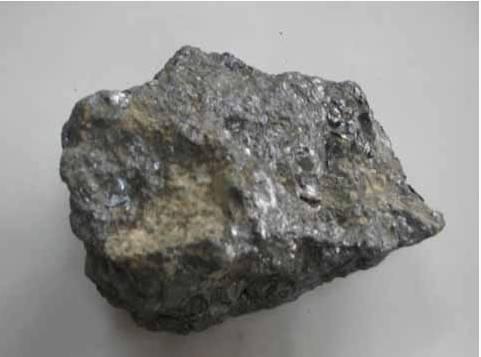Molybdenum is a silvery-grey metal that is quite rare in the Earth's crust. With the chemical symbol Mo and an atomic number of 42, molybdenum was first discovered in 1778 by Carl Wilhelm Scheele. Scheele produced molybdic acid (now called molybdenum trioxide) by reacting molybdenite with nitric acid. The free element was isolated in 1781 by Peter Jacob Hjelm. Molybdenum has a melting point of 2,623 °C (4,753 °F) – only graphite, tungsten and carbon have higher melting points among the elements. It has high corrosion resistance and hardness comparable to that of stainless steel.
Uses in Alloys and Construction
One of molybdenum's most important uses is in the production of different steel alloys. The addition of just 0.5% molybdenum makes steel much harder without significantly reducing its ductility. This allows steel to withstand high pressures and temperatures. Alloy steels containing molybdenum are very resistant to corrosion and erosion and are used in drill bits, oil and gas pipelines and chemical tanks. Molybdenum-containing stainless steels such as SAE 304 and SAE 316 are highly resistant to corrosion from chloride and are commonly used for desalination plants, offshore platforms and cargo ships. Molybdenum-based alloys such as TZM are very refractory with high melting points and are used in furnace parts. Due to its strength and corrosion resistance, molybdenum in its pure form finds applications in rocket combustion chambers, high-temperature furnace walls and laboratory jigs and fixtures.
Uses in Industry and Manufacturing
Molybdenum compounds also have important industrial uses. Molybdenum trioxide is an important catalyst for oil refining processes such as hydrocracking of long-chain hydrocarbons into gasoline. It greatly boosts the efficiency of catalytic converters that are used on vehicles to reduce air pollution. Finely divided molybdenum salts are used to lubricate high-temperature bearings in gas turbines. Molybdenum disulfide is a common dry lubricant added to greases and plastic parts to reduce friction at high temperatures. In manufacturing, molybdenum is used as a binder material for tungsten carbide in cutting tools, drill bits, saws and abrasives. These tools Stay sharp for a long time due to molybdenum's high melting point and hardness. Molybdenum electrodes are used in radio transmitters as they resist high temperatures better than graphite. Molybdenum compounds are widely used as colored pigments in porcelains, glasses and enamels, where they produce green, yellow and blue colors.
Role in Electronics and Renewable Energy
Over the past few decades, molybdenum has found increasing applications in electronics and renewable energy technologies. Its resistance to corrosion makes it suitable for electronic contacts and resistors that must operate reliably for decades. Molybdenum acts as a dopant in the production of semi-conductive materials such as silicon. Compounds containing molybdenum are used as gate insulator films in advanced microelectronics. Molybdenum-containing materials are widely researched for applications in solid oxide fuel cells due to their stability at high temperatures. Molybdenum forms stable non-toxic oxides and has emerged as a replacement material for lead and cadmium in specialty glasses. These new high-tech applications have significantly increased the demand for molybdenum in recent years.
Perhaps molybdenum's biggest growth opportunity will come from its role in renewable energy technologies. Due to its toughness and heat resistance even under acidic conditions, advanced molybdenum alloys are being developed for hydrochloric acid thermal storage applications in concentrated solar power plants. Molybdenum is an important component in nitride superconductors that can be used in wind turbines and maglev trains. Research is ongoing into molybdenum catalysts that can accelerate renewable hydrogen production and carbon dioxide reduction. As solar, wind and hydrogen energy sees massive investments worldwide over the coming decades, molybdenum will play an increasingly vital supporting role in enabling these important clean technologies.
Though rarely seen in its elemental form outside of industrial applications, the chemical element molybdenum quietly permeates our modern industrial economy and high-tech lives. Its unique combination of high melting point, strength, and corrosion resistance has enabled applications as varied as pipelines, bearings, surgical instruments, ceramics and electronics. With ongoing research into new catalysts, energy storage materials and conductive alloys, molybdenum's strategic uses will only multiply. This silvery metal exemplifies how nature's modest elements can make an outsized impact when guided by human ingenuity and technological progress. Molybdenum's Atomic story is still being written.
Select the language you're most comfortable with.
Get More Insights On Molybdenum
https://articlescad.com/molybdenum-with-headings-and-subheadings-meeting-the-specified-517602.html
About Author:
Alice Mutum is a seasoned senior content editor at Coherent Market Insights, leveraging extensive expertise gained from her previous role as a content writer. With seven years in content development, Alice masterfully employs SEO best practices and cutting-edge digital marketing strategies to craft high-ranking, impactful content. As an editor, she meticulously ensures flawless grammar and punctuation, precise data accuracy, and perfect alignment with audience needs in every research report. Alice's dedication to excellence and her strategic approach to content make her an invaluable asset in the world of market insights.
(LinkedIn: www.linkedin.com/in/alice-mutum-3b247b137 )

